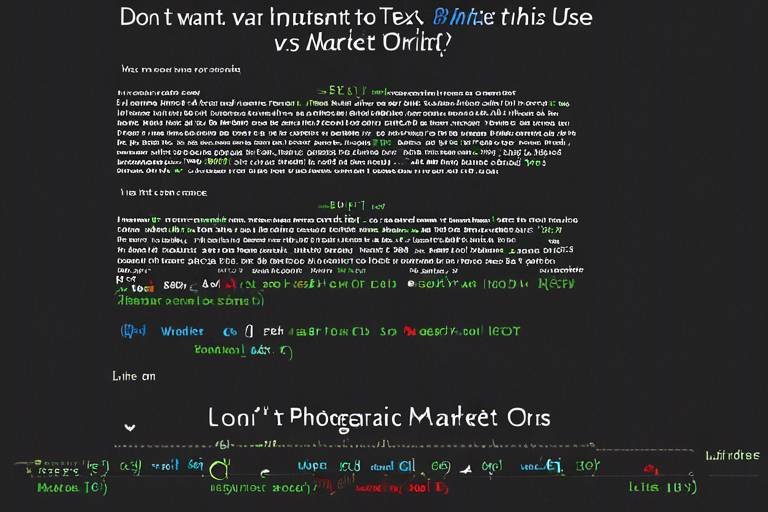How to Use Trend Lines for Better Trading Decisions
When it comes to trading, making informed decisions can feel like navigating a maze without a map. However, one of the most effective tools at your disposal is the trend line. Think of trend lines as your guiding light—they help you see the path of price movements and make sense of the chaos that is the market. In this article, we’ll dive deep into the significance of trend lines, how to draw them accurately, and how they can empower you to make better trading decisions. Whether you’re a seasoned trader or just starting out, understanding trend lines is crucial for improving your trading strategies and outcomes.
Trend lines are fundamental to technical analysis, acting as a visual representation of price movements over time. They help traders identify the direction of the market—whether it’s headed up, down, or sideways. By connecting significant price points on a chart, trend lines allow traders to visualize trends and make predictions about future price movements. The significance of trend lines cannot be overstated; they serve as a foundation for various trading strategies, enabling traders to spot potential entry and exit points. Imagine trying to drive a car without a roadmap; that’s what trading without trend lines feels like!
There are three main types of trend lines: upward, downward, and horizontal. Each type provides different insights into market behavior and can influence your trading decisions in unique ways. Understanding these types is essential for any trader looking to enhance their analysis. Let’s break them down:
Upward trend lines indicate a bullish market, where prices are generally increasing over time. To identify an upward trend line, connect at least two or more low points on a chart, ensuring that the line slopes upward. This visual cue can help traders spot buying opportunities. But how do you effectively utilize upward trend lines in your trading strategy? Well, one key aspect is identifying support levels.
Support levels are price points where a stock tends to stop falling and may bounce back up. By using upward trend lines, traders can pinpoint these support levels more accurately. When the price approaches the trend line, it often indicates a potential buying opportunity. Imagine you’re catching a ball that’s bouncing back up; that’s what support levels represent in the trading world—an opportunity to jump in before the price rises again.
Another critical aspect of using upward trend lines is setting realistic price targets. By analyzing the slope of the trend line and the historical price movements, traders can establish achievable targets for their trades. This practice not only helps in maximizing profits but also in minimizing losses. Think of it as setting a destination before embarking on a journey; it gives you a clear goal and direction.
Conversely, downward trend lines signal a bearish market, indicating that prices are falling. To identify a downward trend line, connect two or more high points on a chart, ensuring the line slopes downward. This type of trend line is essential for traders looking to capitalize on selling opportunities. By recognizing the downward trend, traders can make informed decisions about when to sell or short a stock.
Accurate trend line drawing is crucial for effective analysis and decision-making. Here are some tips to ensure your trend lines are precise:
Different time frames can provide varying insights into market trends. For instance, a trend line drawn on a daily chart may look different from one drawn on a weekly chart. Selecting the appropriate time frame based on your trading strategy can significantly affect the accuracy of your trend lines. If you’re day trading, a shorter time frame might be more beneficial, while long-term investors may prefer a broader perspective.
Even seasoned traders can fall into traps when drawing trend lines. Here are some common pitfalls to watch out for:
- Connecting too few points: Always aim for at least two significant points.
- Ignoring market volatility: Be mindful of price fluctuations that can distort your trend lines.
- Relying solely on trend lines: Use them in conjunction with other indicators for a well-rounded analysis.
By avoiding these mistakes, you can create more reliable trend lines that enhance your trading strategies.
Q: How do I know if a trend line is valid?
A: A trend line is considered valid if it connects multiple significant highs or lows and has been tested by the price action at least two to three times.
Q: Can I use trend lines on any asset?
A: Yes! Trend lines can be applied to various assets, including stocks, forex, and cryptocurrencies, making them versatile tools in trading.
Q: How long should I hold a position based on a trend line?
A: The duration of holding a position depends on your trading strategy and the strength of the trend. Always set your price targets and stop-loss orders based on your analysis.

Understanding Trend Lines
When it comes to trading, understanding the underlying trends in the market is paramount. Trend lines serve as vital indicators that help traders gauge the direction of price movements. But what exactly are trend lines? In simple terms, they are straight lines drawn on a chart that connect significant price points, such as highs or lows, over a specific period. By connecting these points, traders can visualize the overall direction of the market, whether it's moving upward, downward, or remaining stable.
Why should you care about trend lines? Well, they act as a roadmap, guiding traders through the often chaotic landscape of financial markets. Imagine trying to navigate a forest without a map; that's how trading feels without trend lines. They not only help in identifying the direction of the market but also play a crucial role in determining potential support and resistance levels. In essence, trend lines provide clarity amidst the noise, allowing traders to make more informed decisions.
To effectively utilize trend lines, one must understand their significance in trading strategies. They are not just arbitrary lines; they are reflections of market sentiment and behavior. When prices consistently bounce off a trend line, it indicates a strong market sentiment in that direction. Conversely, when prices break through a trend line, it can signal a change in market dynamics, prompting traders to reassess their positions.
Moreover, trend lines can be used in conjunction with other technical analysis tools. For instance, combining trend lines with indicators like moving averages or relative strength index (RSI) can provide a more comprehensive view of market conditions. This multifaceted approach enhances the probability of making successful trades, as it allows traders to confirm signals and reduce the risk of false breakouts.
In summary, trend lines are indispensable tools in the trader's toolkit. They simplify the complex world of price movements, enabling traders to identify opportunities and manage risks more effectively. By mastering the art of drawing and interpreting trend lines, you can elevate your trading game and make decisions that are not only informed but also strategic.

Types of Trend Lines
When it comes to trading, understanding the is crucial for making informed decisions. Trend lines can be categorized into three primary types: upward trend lines, downward trend lines, and horizontal trend lines. Each type serves a specific purpose and can provide valuable insights into market behavior. Let's dive deeper into each type and explore how they can influence your trading strategies.
Upward trend lines are drawn by connecting a series of higher lows on a price chart. These lines indicate a bullish market, suggesting that prices are generally increasing over time. Identifying an upward trend line is like spotting a rising sun; it brings optimism and the potential for profit. Traders often utilize these lines to determine potential entry points into a market, as they reflect a strong buying sentiment.
Support levels are areas on the chart where the price tends to stop falling and may rebound. Upward trend lines play a critical role in identifying these levels. When the price approaches the trend line, it often finds support, making it an ideal point for traders to consider buying. Think of it as a safety net; the trend line provides a cushion against potential losses.
Setting realistic price targets is essential for successful trading. Upward trend lines can assist traders in establishing these targets by projecting future price movements based on past performance. By extending the trend line into the future, traders can estimate where the price might go, allowing them to set achievable goals. This practice helps in maintaining discipline and avoiding emotional decision-making during trades.
Conversely, downward trend lines are drawn by connecting a series of lower highs. These lines indicate a bearish market, highlighting a decline in prices. Recognizing a downward trend line is akin to noticing dark clouds gathering before a storm; it signals caution and the need for strategic planning. Traders can leverage these lines to identify potential exit points or short-selling opportunities, capitalizing on the downward momentum.
Just as upward trend lines help identify support levels, downward trend lines assist in pinpointing resistance levels. Resistance levels are price points where the market tends to stop rising and may reverse direction. When the price approaches a downward trend line, it often encounters resistance, making it a critical area for traders to watch. This is where the market's selling pressure may intensify, providing insights into potential reversals.
For traders looking to profit from declining markets, downward trend lines are invaluable. By analyzing these lines, traders can identify optimal points to enter short positions. This strategy allows them to benefit from falling prices, turning market downturns into profit opportunities. It's like surfing a wave; the key is to ride it at the right moment for maximum gain.
Horizontal trend lines are drawn across a price chart at a level where the price has consistently bounced between two points, creating a range. These lines indicate a period of consolidation, where buyers and sellers are in equilibrium. Horizontal trend lines can be thought of as a tug-of-war between bulls and bears, and understanding this dynamic is essential for traders. They help identify breakout points, where the price may either rise above resistance or fall below support, signaling a potential trend change.
In summary, recognizing the different types of trend lines is fundamental for any trader. Each type—upward, downward, and horizontal—provides unique insights that can guide trading decisions. By mastering these tools, traders can navigate the market with greater confidence and precision.
- What is the importance of trend lines in trading? Trend lines help traders identify market direction, support and resistance levels, and potential entry and exit points.
- How do I draw a trend line accurately? To draw a trend line accurately, connect at least two significant price points and ensure the line reflects the overall price movement.
- Can trend lines guarantee successful trades? No, while trend lines are valuable tools, they should be used in conjunction with other analysis methods for better trading outcomes.

Upward Trend Lines
When it comes to trading, understanding the nuances of can be your golden ticket to navigating the markets with confidence. These lines are like guiding stars in a trader's sky, helping you pinpoint moments when prices are likely to rise. An upward trend line is drawn by connecting the lows of price movements on a chart, creating a visual representation of a bullish market. But how do you identify these lines effectively? It’s all about recognizing the higher lows that form as prices increase over time.
Imagine you’re hiking up a mountain. Each step you take up the trail represents a low point on your journey, and as you ascend, you notice that each step is slightly higher than the last. This is similar to how upward trend lines function in trading. They indicate a consistent pattern of increasing prices, which can be a clear signal for traders looking to enter the market. But it’s not just about spotting these lines; it’s about leveraging them to make informed decisions.
One of the most powerful aspects of upward trend lines is their ability to help traders identify support levels. A support level is a price point where a stock tends to stop falling and may rebound. When you draw an upward trend line, you’re essentially mapping out these support levels. As prices approach this line, they often bounce back, providing traders with an opportunity to buy at lower prices before the next upward move. This creates a strategic advantage, allowing you to enter trades at opportune moments.
Moreover, upward trend lines are instrumental in setting price targets. By analyzing the slope of the trend line, traders can estimate potential price movements. For instance, if the upward trend line has a steep angle, it indicates a strong bullish sentiment, suggesting that prices might continue to rise significantly. Conversely, a more gradual slope may indicate a slower price increase. By understanding these dynamics, you can set realistic price targets that align with market trends, enhancing your chances of achieving profitable trades.
To illustrate the concept of upward trend lines, consider the following table:
| Market Condition | Trend Line Characteristics | Trading Strategy |
|---|---|---|
| Bullish Market | Higher lows connected by a line | Buy on dips near the trend line |
| Strong Bullish Sentiment | Steep upward slope | Set aggressive price targets |
| Weak Bullish Sentiment | Gradual upward slope | Set conservative price targets |
In summary, upward trend lines are not just lines on a chart; they are powerful tools that can significantly enhance your trading decisions. By identifying higher lows, recognizing support levels, and setting price targets based on these lines, you can navigate the market with greater precision. So, the next time you analyze a chart, pay close attention to those upward trend lines—they might just lead you to your next big trading opportunity!

Identifying Support Levels
Identifying support levels is a crucial aspect of trading that can significantly enhance your decision-making process. Support levels are essentially price points where a stock or asset tends to stop falling and may even bounce back upwards. Think of it as a safety net for traders; when prices approach these levels, they often signal a potential reversal, making them prime opportunities for buying. But how do you pinpoint these magical levels?
First off, upward trend lines play a pivotal role in identifying support levels. When you draw an upward trend line, you connect the lows of the price movements. This line acts as a visual representation of the support level. Whenever the price approaches this line, it’s a signal to watch closely. If the price bounces off the trend line, it reinforces the idea that the support level is valid. However, if the price breaks below this line, it could indicate a shift in market sentiment, leading to further declines.
Moreover, understanding the psychology behind support levels can also be beneficial. Traders often place buy orders around these levels, anticipating that others will do the same. This collective behavior can create a self-fulfilling prophecy, where the price indeed bounces back due to the influx of buying activity. It’s like a crowd at a concert; when the energy rises, everyone joins in, creating a wave of excitement. Similarly, as traders see the price approaching a support level, they might rush to buy, pushing the price back up.
To illustrate this concept further, consider the following table that summarizes the key characteristics of support levels:
| Characteristic | Description |
|---|---|
| Price Reversal | Support levels often lead to price reversals where the asset bounces back. |
| Increased Buying Activity | Traders tend to place buy orders near these levels, creating upward pressure. |
| Market Sentiment | A break below support can indicate a bearish shift in market sentiment. |
In addition, it’s important to combine trend lines with other technical indicators for a more robust analysis. For instance, using moving averages or oscillators can provide additional confirmation of the strength of a support level. If multiple indicators align at the same price point, it adds credibility to the support level you’ve identified. It’s like having multiple friends vouch for a restaurant; the more recommendations you get, the more likely you are to visit!
In conclusion, identifying support levels through upward trend lines not only helps traders make informed decisions but also enhances their confidence in their trading strategies. By understanding the dynamics of support levels and their psychological implications, you can position yourself better in the market. Remember, trading is not just about numbers; it’s about understanding the story behind those numbers.

Setting Price Targets
When it comes to trading, is not just a good practice; it's a crucial part of a successful strategy. Think of it as having a roadmap for your trading journey. Without clear destinations, you might find yourself wandering aimlessly, unsure of when to take profits or cut losses. Price targets help you define specific levels at which you plan to exit your trades, ensuring that your decisions are based on analysis rather than emotion.
To set effective price targets, you can utilize the information provided by upward trend lines. These lines not only indicate the overall direction of the market but also help you identify potential exit points. For instance, if you have established an upward trend line, you can project future price movements by extending the line into the future. This projection can serve as a guide for setting your price targets.
Moreover, it's beneficial to consider the risk-to-reward ratio when setting your price targets. This ratio helps you evaluate whether the potential reward of a trade justifies the risk involved. A common guideline is to aim for a risk-to-reward ratio of at least 1:2, meaning for every dollar you risk, you should aim to gain two. This approach not only helps in managing your trades effectively but also contributes to long-term profitability.
Additionally, you can enhance your price target strategy by incorporating other technical indicators, such as Fibonacci retracement levels or moving averages. These tools can provide further confirmation for your price targets, making your trading decisions more robust. For example, if your upward trend line intersects with a significant Fibonacci level, it could indicate a strong potential price target.
Here’s a simple table to illustrate how you might set price targets based on trend lines:
| Trade Type | Entry Point | Price Target (Using Trend Line) | Risk-to-Reward Ratio |
|---|---|---|---|
| Long Position | $50 | $60 | 1:2 |
| Long Position | $70 | $85 | 1:3 |
In conclusion, setting price targets is an essential part of any trading strategy. By using upward trend lines, analyzing risk-to-reward ratios, and integrating other technical indicators, traders can create a comprehensive plan that enhances their chances of success. Remember, the clearer your targets, the more focused your trading decisions will be, allowing you to navigate the markets with confidence.
- What is a price target in trading? A price target is a specific level at which a trader plans to exit a trade, either to take profits or to cut losses.
- How do I determine my price target? Price targets can be determined using trend lines, technical indicators, and analysis of market conditions.
- Why is the risk-to-reward ratio important? The risk-to-reward ratio helps traders assess whether the potential profit of a trade outweighs the potential loss, guiding them in making informed decisions.
- Can I adjust my price targets? Yes, price targets can be adjusted based on changing market conditions and new information.

Downward Trend Lines
Downward trend lines are an essential component of technical analysis, particularly for traders who want to navigate the often-turbulent waters of a bearish market. When you spot a downward trend line, it’s like seeing a red flag waving in the distance, indicating that prices are likely to continue their descent. These lines are drawn by connecting a series of lower highs, creating a visual representation of a market that is losing momentum. But how can you effectively identify and leverage these downward trend lines in your trading strategies? Let’s dive deeper.
First and foremost, it’s crucial to understand that a downward trend line signifies a bearish market. This means that the prevailing sentiment among traders is negative, leading to a series of price declines. Identifying these lines can help you make informed decisions about when to enter or exit trades. When prices touch the downward trend line, it can often serve as a resistance level, where traders might consider selling or shorting their positions. Think of it as a ceiling that prices struggle to break through. If you're looking to capitalize on falling prices, knowing how to read these lines is fundamental to your success.
To effectively utilize downward trend lines, you need to pay attention to a few key factors:
- Volume Analysis: Look for increased trading volume at points where prices approach the trend line. A surge in volume can indicate strong selling pressure.
- Confirmation: Always wait for price action to confirm your trend line. A break below the trend line can signal a continuation of the downward movement.
- Multiple Touch Points: The more times the price touches the trend line without breaking through, the stronger the trend line becomes.
One of the most effective ways to use downward trend lines is by incorporating them into your overall trading strategy. For instance, if you identify a downward trend line that has been respected multiple times, you can set your stop-loss orders just above this line. This way, if the market does turn against you, your losses will be minimized. Conversely, if the price breaks above the trend line, it could signal a potential reversal, prompting you to reevaluate your position.
Additionally, downward trend lines can help in setting realistic price targets. By analyzing previous price movements and the angle of the trend line, you can estimate where the price might head next. This foresight can be invaluable, allowing you to make strategic decisions rather than reactive ones. Imagine you’re on a road trip; the trend line acts like your GPS, guiding you through the twists and turns of the market.
In summary, understanding and effectively utilizing downward trend lines is a powerful skill for any trader. They not only provide insights into market sentiment but also help in making informed decisions about entry and exit points. By combining your knowledge of downward trend lines with other technical indicators, you can create a robust trading strategy that stands the test of time.
Q1: What is a downward trend line?
A downward trend line is a straight line drawn on a price chart that connects a series of lower highs, indicating a bearish market where prices are generally declining.
Q2: How do I identify a downward trend line?
To identify a downward trend line, look for at least two or three lower highs on a price chart. Draw a line connecting these highs, and extend it to project future price movements.
Q3: Can downward trend lines be used for short selling?
Yes, downward trend lines are often used by traders to identify potential short-selling opportunities, especially when prices approach the trend line and show signs of resistance.
Q4: How do I set stop-loss orders using downward trend lines?
Place your stop-loss orders just above the downward trend line. This helps protect your investment in case the price moves against your position.

Drawing Trend Lines Accurately
Accurate trend line drawing is not just an art; it's a science that can significantly enhance your trading decisions. Imagine trying to navigate through a dense forest without a map—trading without properly drawn trend lines can feel just as chaotic. To effectively analyze price movements and make informed decisions, you need to master the technique of drawing trend lines accurately. So, how do you do that?
First and foremost, it's essential to understand that trend lines should connect at least two significant points on a price chart. These points can be peaks or troughs, and they serve as the backbone of your analysis. However, it's not just about connecting dots; you must also consider the overall market context. For instance, if you're drawing an upward trend line, ensure it aligns with the general bullish sentiment of the market. This alignment creates a reliable framework for your trading strategy.
Another critical aspect is the choice of time frame. Different time frames can yield different insights, and the trend line's significance can vary based on the duration you select. For example, a trend line drawn on a daily chart may show a different market sentiment compared to one drawn on a 15-minute chart. It's often beneficial to analyze multiple time frames to gain a comprehensive view of the market. This practice allows you to identify potential entry and exit points more effectively.
When drawing trend lines, avoid common mistakes that traders often make. One of the most prevalent errors is drawing trend lines too loosely. A trend line should be a definitive guide, not a vague suggestion. Ensure that your trend lines touch as many price points as possible while still maintaining the overall trend direction. This precision can make a significant difference in your trading decisions.
To illustrate the importance of accuracy in drawing trend lines, consider the following table that showcases the impact of different trend line placements on potential trade outcomes:
| Trend Line Placement | Potential Outcome |
|---|---|
| Accurate Trend Line | Higher probability of successful trades |
| Loose Trend Line | Increased risk of false signals |
| Ignoring Market Context | Potential losses due to misinterpretation |
In conclusion, drawing trend lines accurately is a vital skill for any trader looking to improve their market analysis and decision-making process. By connecting significant price points, choosing the right time frames, and avoiding common pitfalls, you can create a robust framework for your trading strategies. Remember, the clearer your trend lines, the clearer your trading path will be!
- What is a trend line? A trend line is a straight line that connects two or more price points on a chart, helping traders identify the direction of price movements.
- How do I know if my trend line is accurate? An accurate trend line should touch multiple price points while maintaining the overall trend direction. The more points it connects, the more reliable it is.
- Can I use trend lines on any time frame? Yes, trend lines can be drawn on any time frame. However, the significance of the trend line may vary based on the duration you select.
- What are common mistakes when drawing trend lines? Common mistakes include drawing trend lines too loosely, ignoring market context, and failing to connect enough significant price points.

Choosing the Right Time Frame
When it comes to trading, one of the most critical decisions you'll make is selecting the right time frame for your analysis. Think of it as choosing the lens through which you view the market; different lenses can reveal different details. For instance, a short-term trader might focus on minute-by-minute charts, while a long-term investor may look at daily or weekly charts. Each time frame offers unique insights and can significantly alter your trading decisions.
To further understand the importance of time frames, let's break it down into a few key considerations:
- Market Volatility: In a highly volatile market, shorter time frames might be more beneficial as they allow traders to react quickly to price movements. Conversely, in a stable market, longer time frames can help capture larger price movements without the noise of minor fluctuations.
- Trading Style: Your personal trading style plays a crucial role. Day traders often utilize 1-minute to 15-minute charts, while swing traders may prefer 4-hour or daily charts. Understanding your style is essential in selecting the appropriate time frame.
- Time Commitment: How much time can you dedicate to trading? If you have a full-time job, longer time frames may suit you better, allowing you to make decisions without constantly monitoring the market.
Moreover, it's essential to recognize that the time frame you choose can affect your trend line analysis. For example, a trend line drawn on a 5-minute chart may suggest a different market sentiment compared to one drawn on a daily chart. This discrepancy can lead to conflicting trading signals, which is why it's vital to maintain consistency in your analysis.
To illustrate this point, consider the following table that compares different time frames and their implications:
| Time Frame | Best For | Typical Duration of Trades |
|---|---|---|
| 1-Minute | Scalping | Seconds to Minutes |
| 15-Minute | Day Trading | Minutes to Hours |
| 1-Hour | Short-Term Trading | Hours to Days |
| Daily | Swing Trading | Days to Weeks |
| Weekly | Long-Term Investing | Weeks to Months |
Ultimately, the right time frame is a personal choice that aligns with your trading goals, risk tolerance, and lifestyle. Experimenting with different time frames can provide you with a broader perspective of market trends and help you make more informed decisions. Just remember, the key to successful trading is not just in the analysis but also in how well you understand the market dynamics at play.

Common Mistakes to Avoid
When it comes to trading, even the most seasoned traders can fall into the trap of making common mistakes with trend lines. One of the biggest errors is drawing trend lines too loosely. It's tempting to connect just any two points on a chart, but this can lead to misleading signals. A trend line should connect at least three points to establish a reliable trend. If you’re only connecting two points, you might as well be flipping a coin!
Another frequent mistake is ignoring the overall market context. Trend lines don’t exist in a vacuum. They should be analyzed in conjunction with other indicators, such as volume and momentum. For instance, if you see an upward trend line but the volume is decreasing, it might be a sign that the trend is losing strength. It’s like trying to navigate a ship without looking at the weather; you might end up in choppy waters!
Additionally, many traders fail to adjust their trend lines as new price data emerges. A trend line drawn today may not hold its relevance tomorrow as the market evolves. Regularly revisiting your trend lines and adjusting them based on the latest price movements is crucial. If you don’t, you could be sailing straight into a storm without a compass.
Moreover, not considering the time frame is another pitfall. A trend line that appears significant on a 5-minute chart may not hold the same weight on a daily chart. Always consider your trading strategy and the time frame you are working within. Think of it like looking at a map; zooming in can give you details that might be missed when viewed from afar.
Lastly, over-relying on trend lines without incorporating other forms of analysis can lead to poor trading decisions. While trend lines are a powerful tool, they should be part of a broader trading strategy that includes fundamental analysis and other technical indicators. This holistic approach is akin to a well-balanced diet; relying solely on one food group will not provide the nutrients you need for success.
In summary, avoiding these common mistakes can significantly enhance your trading decisions. By being mindful of how you draw trend lines, considering the broader market context, and integrating multiple forms of analysis, you can navigate the trading waters with greater confidence and skill.
- What is a trend line?
A trend line is a straight line that connects two or more price points on a chart, helping to visualize the direction of price movements.
- How do I draw a trend line?
To draw a trend line, identify at least two significant price points and connect them with a straight line, ensuring the line respects the price action of the chart.
- Can trend lines predict future prices?
While trend lines can indicate potential future price movements based on past behavior, they should not be solely relied upon for predictions.
- How often should I adjust my trend lines?
It's advisable to adjust your trend lines regularly, especially when new price data emerges or significant market events occur.
Frequently Asked Questions
- What are trend lines and why are they important in trading?
Trend lines are straight lines drawn on a price chart that connect significant price points, helping traders visualize the direction of price movements. They are crucial because they provide insights into market trends, allowing traders to make informed decisions about when to enter or exit trades.
- How do I identify an upward trend line?
An upward trend line is drawn by connecting the lowest points of a price chart over a specific period, indicating a series of higher lows. To identify it, look for at least two or three significant lows that can be connected with a straight line. This line helps traders spot potential support levels where prices may bounce back up.
- What is the difference between upward and downward trend lines?
Upward trend lines indicate a bullish market, showing that prices are generally increasing over time, while downward trend lines signal a bearish market, where prices are declining. Understanding the difference helps traders align their strategies with the prevailing market conditions.
- How can trend lines help in setting price targets?
Trend lines assist traders in setting realistic price targets by projecting future price movements based on historical trends. By analyzing the angle and distance of the trend line, traders can estimate where the price might head next, allowing them to plan their trades more effectively.
- What common mistakes should I avoid when drawing trend lines?
Some common mistakes include drawing trend lines too steeply, ignoring significant price points, or failing to adjust them as new data emerges. It's essential to ensure that trend lines are based on clear price movements and not forced onto the chart, which can lead to misleading conclusions.
- How does the time frame affect the accuracy of trend lines?
The time frame you choose can significantly impact the reliability of trend lines. Shorter time frames may show more volatility and noise, making trend lines less reliable, while longer time frames tend to smooth out fluctuations and provide a clearer picture of the overall trend.



















